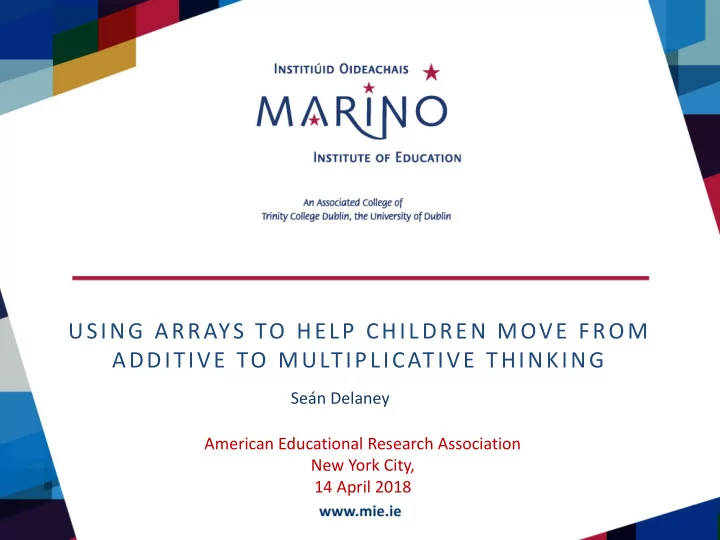

USING ARRAYS TO HELP CHILDREN MOVE FROM ADDITIVE TO MULTIPLICATIVE THINKING Seán Delaney American Educational Research Association New York City, 14 April 2018
2-D ARRAYS & MULTIPLICATION
MATHEMATICS PROBLEM Our local cinema has 26 rows of seats with 14 seats in each row. How many seats are in the cinema altogether?
26 x 14
COMMUTATIVE PROPERTY OF MULTIPLICATION 26 x 14 = 14 x 26 Commutative Property
26 x 14 = (26 x 10) + (26 x 4) Distributive Property
26 x 14 = (20 x 10) + (20 x 4) + (6 x 10) + (6 x 4)
EVIDENCE OF UNDERSTANDING OF MULTIPLICATION (LAMPERT, 1986) Physical counting Memorization Intuitive knowledge (how people working in contexts invent particular ways to calculate) Computational knowledge (using procedures such as standard algorithms) Concrete knowledge (manipulating objects to find answers) Principled knowledge (drawing on principles such as place value, commutativity or operations or the distributive property of multiplication)
RESEARCH QUESTIONS 1. What strategies did children invent to solve a problem requiring the multiplication of two two-digit numbers? 2. What evidence of multiplicative thinking did children show in their written work?
THEORETICAL FRAMEWORK 3 Areas of research • Transition from invented algorithms (Kamii & Baker- Housman, 2000) to progressive schematisation or progressive mathematisation (Selter 1998; Streefland, 1992; Treffers, 1987) • Difficulties and benefits of learning to use arrays – five steps (Outhred & Mitchelmore, 2000) • Transition from additive to multiplicative thinking (Carpenter, Franke, & Levi, 2003; Lampert, 1986 Nunes & Bryant, 1996; Van Dooren, De Bock & Verschaffel, 2010; Vergnaud, 1988)
MODE OF INQUIRY Practitioner Inquiry (Cochran-Smith & Donnell, 2006) • Using practice as a site for research (Lampert & Ball, 1998) • 18 children (11 girls and 7 boys) • Laboratory class (1 week, 10 hours) Completed 3 rd grade; 7 different schools; six students • from schools serving areas traditionally associated with social and economic disadvantage • Had done algorithm for short multiplication in school but none had done long multiplication • Teaching observed by 12 teachers • Data sources: children’s written work and teacher’s planning notes
PRACTICE/RESULTS Day 2 • Use square pattern blocks to construct a rectangular shape – array – with rows and columns that shows 6 x 3 • How is 6 x 3 different to 3 x 6? • Use the pattern blocks to represent 5 x 4 • Create arrays of your own choosing. • Record one array in your notebook • Show 5 x 5 in one colour. Add two more columns with five tiles (of a different colour) to this array.
PRACTICE/RESULTS Day 3 • Final array for previous day was revisited and children were asked to complete the equation 7 x 5 = (5 x __) + (2 x __) and to reproduce the array in their notebooks • How could you calculate 12 x 9 using a similar principle? • Homework: Fill a given rectangle with an array to show the product of 12 x 7. (Discussed briefly next morning).
PRACTICE/RESULTS Day 4 • Arrays on paper were partitioned, colour-coded and distributed to children showing arrangements of the tiles such as (8 x 10) + (8 x 7) = (8 x 17); (6 x 10) + (6 x 3) = (6 x 13) and (7 x 20) + (7 x 4) = (7 x 24) • How many tiles in each array? • Why do you think the arrays were partitioned as they were? • Some children noticed that the partitioning made it easier to find the product. • Create an array that would make it easier to multiply 8 x 21
PRACTICE/RESULTS Day 5 • Cinema seat problem (26 x 14) • Solve it any way you wish • All but three children used an array to solve the problem • 6 children produced the correct answer (5 of the 6 used arrays).
ANALYSIS Concrete knowledge (using drawn array) and computational knowledge (using prior knowledge of multiplication number facts up to 10 x 10) used by most children Principled knowledge (using knowledge of place value or distributive property to help partition the array) used by some children Several children needed more time: Some grasped concept of arrays but not the benefit of grouping numbers in tens One child attempted to construct an array using each individual seat/tile rather than using scaling Only one child used repeated addition (in previous year, when arrays were not introduced, half the class used repeated addition or a variation of it to complete a similar problem)
SCHOLARLY SIGNIFICANCE Arrays are difficult for children initially Benefits for learning – especially moving towards multiplicative thinking – are possible if teachers persist with them Short time available – problems could be remediable Working with arrays is not widely practised Working with arrays in a classroom context is messy More context-based studies of the transition from additive to multiplicative thinking – using arrays and other methods – are needed if we are to fulfil, achieve and demonstrate one micro aspect of the Dreams, Possibilities and Necessity of Public Education
THANK YOU Contact Details • www.seandelaney.com • sean.Delaney@mie.ie
Recommend
More recommend